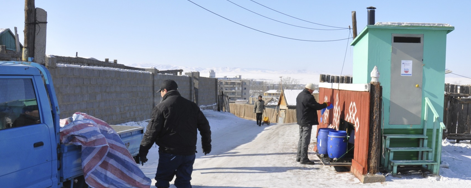- Resource recovery
- Resource recovery from excreta, faecal sludge or wastewater
- PhD thesis: Integrated Sanitation Systems Based On Material-Flows - in the City of Darkhan, Mongolia
PhD thesis: Integrated Sanitation Systems Based On Material-Flows - in the City of Darkhan, Mongolia
6521 views
Re: Integrated Sanitation Systems Based On Material-Flows - Download Dissertation
muench wrote: I'd also like to know more about your ipit system and how it differs from a normal UDDT? Do you have any photos or schematics for it, perhaps in the same powerpoint file
www.ipit.eu/design_en.html
(mainly the easy road-side access for container exchange I guess)
But they do look very familiar from previous discussions we had on the old ACF initiative. See:
www.susana.org/en/knowledge-hub/resource...library/details/2391
Please Log in to join the conversation.
You need to login to reply- Elisabeth
-
- User is blocked
- Freelance consultant since 2012
Less- Posts: 3372
- Karma: 54
- Likes received: 932
Re: Integrated Sanitation Systems Based On Material-Flows - Download Dissertation
Congratulations on getting your PhD thesis finished, Jürgen!
I've had a quick look through your document... Could you provide us with a powerpoint presentation that you perhaps used to present/defend your thesis? I find such a presentation is very useful to get a quick overview.
I'd also like to know more about your ipit system and how it differs from a normal UDDT? Do you have any photos or schematics for it, perhaps in the same powerpoint file?
Is there some follow-on work taking place in Mongolia after you completed your research and pilot project there? Will the sanitation situation improve in those settlements that you studied?
Regards,
Elisabeth
I've had a quick look through your document... Could you provide us with a powerpoint presentation that you perhaps used to present/defend your thesis? I find such a presentation is very useful to get a quick overview.
I'd also like to know more about your ipit system and how it differs from a normal UDDT? Do you have any photos or schematics for it, perhaps in the same powerpoint file?
Is there some follow-on work taking place in Mongolia after you completed your research and pilot project there? Will the sanitation situation improve in those settlements that you studied?
Regards,
Elisabeth
Dr. Elisabeth von Muench
Freelance consultant on environmental and climate projects
Freelance consultant on environmental and climate projects
Please Log in to join the conversation.
You need to login to replyIntegrated Sanitation Systems Based On Material-Flows - Download Dissertation
Development, Implementation and Operation of Integrated Sanitation Systems Based on Material-Flows – Integrated Sanitation in the City of Darkhan, Mongolia - A Practicable Example
Please click on the following link to the download page of the dissertation:
e-pub.uni-weimar.de/opus4/frontdoor/index/index/docId/3179
Abstract:
This dissertation examines the possibility to enhance “access to sanitation” for people who are living in areas with underdeveloped water and wastewater infrastructure systems. The idea hereby is to follow an integrated approach for sanitation, which allows for a mutual completion of existing infrastructure with resource-based sanitation systems.
The notion “integrated sanitation system (iSaS)” is defined in this work and guiding principles for iSaS are formulated. Further on the implementation of iSaS is assessed at the example of a case study in the city of Darkhan in Mongolia. More than half of Mongolia’s population live in settlements where yurts (tents of Nomadic people) are predominant. In these settlements (or “ger areas”) sanitation systems are not existent and the hygienic situation is precarious.
An iSaS has been developed for the ger areas in Darkhan and tested over more than two years. Further on a software-based model has been developed with the goal to describe and assess different variations of the iSaS. The results of the assessment of material-flows, monetary-flows and communication-flows within the iSaS are presented in this dissertation. The iSaS model is adaptable and transferable to the socio-economic conditions in other regions and climate zones.
Please click on the following link to the download page of the dissertation:
e-pub.uni-weimar.de/opus4/frontdoor/index/index/docId/3179
Abstract:
This dissertation examines the possibility to enhance “access to sanitation” for people who are living in areas with underdeveloped water and wastewater infrastructure systems. The idea hereby is to follow an integrated approach for sanitation, which allows for a mutual completion of existing infrastructure with resource-based sanitation systems.
The notion “integrated sanitation system (iSaS)” is defined in this work and guiding principles for iSaS are formulated. Further on the implementation of iSaS is assessed at the example of a case study in the city of Darkhan in Mongolia. More than half of Mongolia’s population live in settlements where yurts (tents of Nomadic people) are predominant. In these settlements (or “ger areas”) sanitation systems are not existent and the hygienic situation is precarious.
An iSaS has been developed for the ger areas in Darkhan and tested over more than two years. Further on a software-based model has been developed with the goal to describe and assess different variations of the iSaS. The results of the assessment of material-flows, monetary-flows and communication-flows within the iSaS are presented in this dissertation. The iSaS model is adaptable and transferable to the socio-economic conditions in other regions and climate zones.
Dr.-Ing. Jürgen Stäudel
LotusConsulting
Paul-Schneider-Str.13
D-99423 Weimar
Web: www.lotusconsulting.eu
iPiT-website: www.ipit.eu
email: This email address is being protected from spambots. You need JavaScript enabled to view it.
LotusConsulting
Paul-Schneider-Str.13
D-99423 Weimar
Web: www.lotusconsulting.eu
iPiT-website: www.ipit.eu
email: This email address is being protected from spambots. You need JavaScript enabled to view it.
Attachments:
-
 Collection...iPiT.png
(Filesize: 168KB)
Collection...iPiT.png
(Filesize: 168KB)
Please Log in to join the conversation.
You need to login to reply
Share this thread:
- Resource recovery
- Resource recovery from excreta, faecal sludge or wastewater
- PhD thesis: Integrated Sanitation Systems Based On Material-Flows - in the City of Darkhan, Mongolia
Recently active users. Who else has been active?
Time to create page: 0.142 seconds








